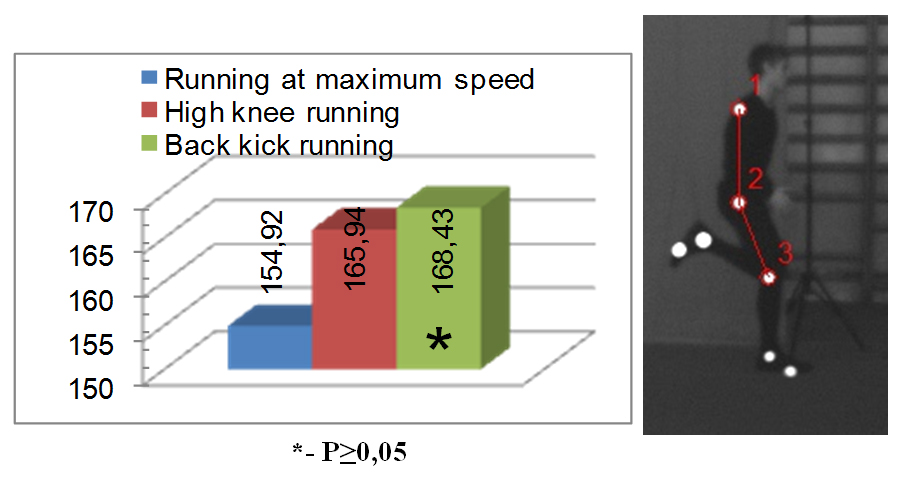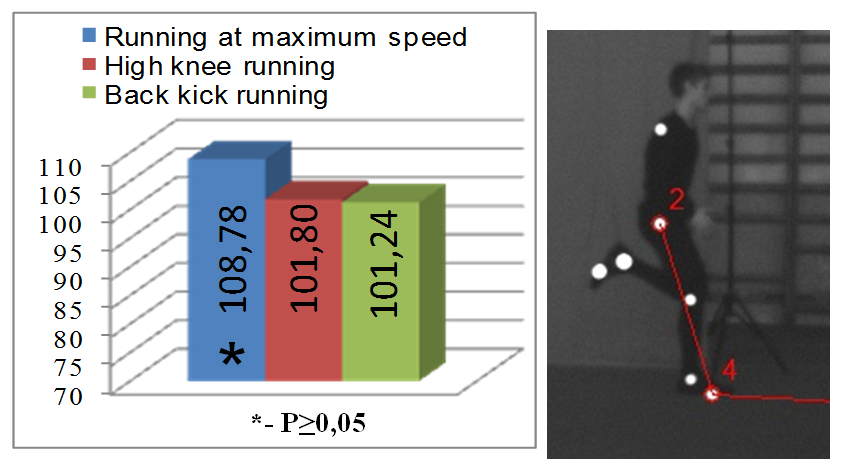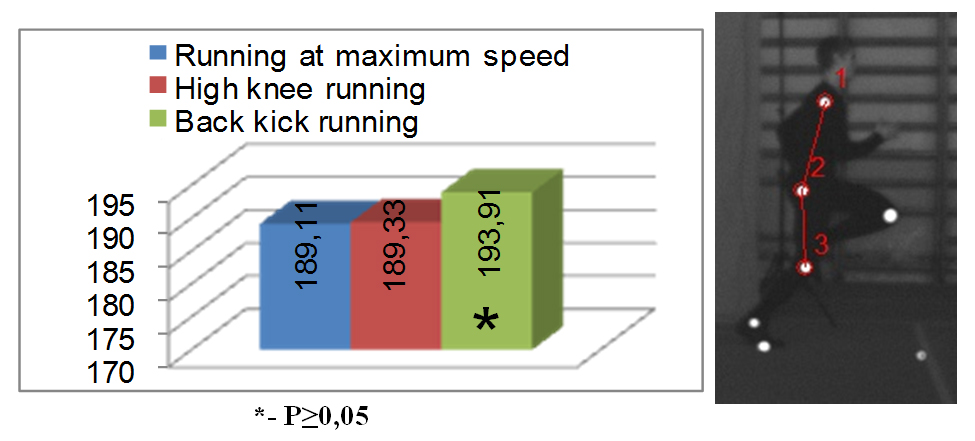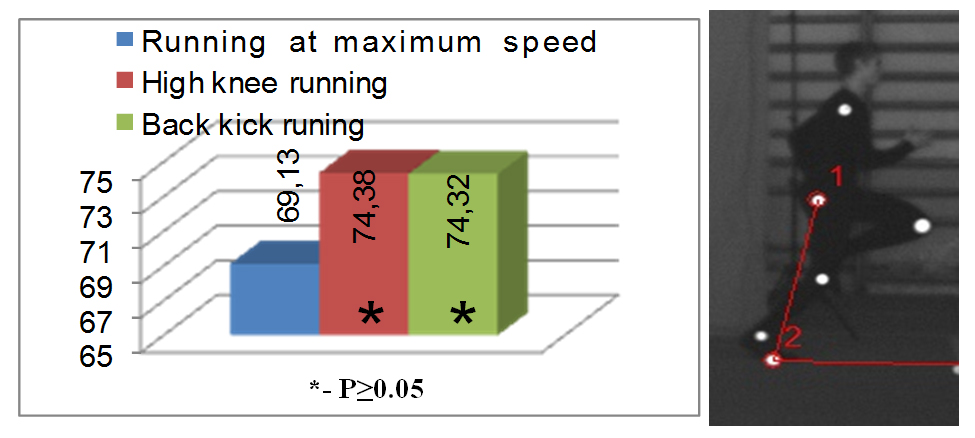Kinematic analysis of endurance running technique and special running exercises
Фотографии:
ˑ:
Associate professor, Ph.D. J.V. Nikulina
Associate professor, Ph.D. A.A. Petrov
Associate professor, Ph.D. A.S. Maksimov
Associate professor V.Yu. Ershov
V.A. Nikulin
Velikie Luki State Academy of Physical Culture and Sport, Velikie Luki
Keywords: running technique, kinematic characteristics of running, foot angle, take-off angle.
Introduction. The distance run speed depends on the optimal form of movements, the ability to run without undue tension [4]. When taking off, the foot should be behind the projection of the common center of mass (CCM). Only in this case a sprinter, so to speak, slides along the track, consuming minimum energy. The knee angle of the swing-up leg when taking off equals on the average to 780, varying individually between 640 and 9-8. This angle is larger in all third-class sprinters compared to the high-class ones, whose lower leg bends too much and the heel almost touches the buttock [1]. With increasing running speed the vertical performance decreases, and the efficiency of running increases. More skilled runners perform less vertical work [5].
The experiments have proved that with an increase in the running speed the foot is placed more rigorously, i.e. stiffed in the knee and ankle joints, the height of the running "set" increases, and the flapping angle of CCM and the take-off angle become more acute. In addition, with increasing running speed the scope of the hips and shoulders inevitably expands, as well as the back kick range. A number of other factors are not associated with the running speed. They are: foot angle and knee angle of the support foot at the time of taking off. The comparative analysis of the technique of different sprinters revealed that the lower leg "whip" angle did not depend on the running speed, although when comparing different runs of one and the same sprinter, there was detected a relationship - the higher the running speed, the less acute the lower leg "whip" [7].
A decrease in the vertical oscillations of CCM increases the efficiency of running locomotions significantly. The way the foot is placed on a support determines the rate of amortization phase, the degree of utilization of spring functions of the foot during amortization and efficiency of the kinematic energy recuperation into potential energy of the pre-stretched muscles and tendons. Motor experience imposes the typical features on the technique of their running locomotions [8]. The modern methods of video analysis enable us to estimate the motion kinematics rapidly and to a high degree of accuracy.
The purpose of the study was to investigate the angular parameters of the technique of running at maximum speed in runners (n = 12) of different skill levels.
Materials and methods. The object of the study was the technique of running at maximum speed and special running exercises for sprinters of different skill levels.
The kinematic characteristics were determined in certain positions and time during running exercises and when running at maximum speed using 3D-video analysis, with the help of the hardware and software complex "Videoanalysis - Statokin" (Russia).
To capture video sequences using the analysis system "Videoanalysis - Statokin", we attached the 2 сm reflective markers to the lateral side of the body of 12 male athletes aged 18-22 years with the sports qualifications from the 3rd Class to CMS were attached; they were offered to perform the running exercises at the distance sections up to 30 m. Footage was processed using the "3D VideoMotion" software.
Results and discussion. During the video analysis we obtained the kinematic parameters of the technique of running at maximum speed and running exercises. We determined the hip angle at the moment of placing the foot on a support when performing different exercises (Fig. 1).

Fig. 1. Hip angle when placing foot on support when performing different exercises
At the mean, the largest angle value in the study group was registered during the back kick run - 1680, during the high knee run - less by 1.5%; and when running at maximum speed - this angle had the smallest average value of 1550 (8%) (p≥0,05). We noticed that an increase in the running speed at the moment of placing the foot on a support caused an athlete's body to lean forward. A number of scientific studies [2, 3] also trace back the relationship as follows: the higher the speed, the larger the angle body. The foot angle should fit the running speed, the higher the speed, the farther the foot is placed on the track relative to the CCM projection.
The following figure (Fig. 2) shows that, on the average, the largest angle value in the study group when placing the foot on a support while running at maximum speed was equal to 1090. When performing the running exercises, the angles were insignificantly (p≤0.05) less by 6% (101.80 and 101.240, respectively). According to the literature data, in elite sprinters this angle equaled 1160.
In case the foot angle increases, the lower leg "whips" forward excessively and "hits" upon the support, which, as a result, leads to slowdown and loss of the running speed. If the foot angle decreases, the step length reduces, which also has a negative impact on the result with a high degree of inverse correlation (r=-0.66). We observed that the majority of athletes of the study group performed the technical actions shortening their steps.

Fig. 2. Foot angle when performing different exercises
In going from crouching to taking off, the hip and knee angles change in multiple directions. During the active hip extension there is a flexion in the knee joints. This motion enables the two-joint muscles of the thigh to contract for a long time in the inferior and isometric modes, and thus create greater traction on the bone [6]. We found that during the back kick run the hip angle at the time of taking off (Fig. 3) was on the average 1940, which is by 2.5% (p ≤ 0.05) larger compared with running at maximum speed and high knee running equal to 1890. This testifies to the similarity of movements and, as a result, high efficiency of this running exercise in the formation of the running motor skill.

Fig. 3. Hip angle when taking off from a support while performing different exercises
While performing the running exercises at the relatively low travel speed, the take-off angle (Fig. 4) in the subjects equaled 740, when running at maximum speed it was less by 7% - 690, and in elite sprinters, as shown in special literature, this index was even lower - 620. By comparison, at the Beijing Olympics, Usain Bolt with his world record demonstrated the technique with the take-off angle of 60-650. That is, the higher the running speed, the smaller the take-off angle (r = -0,37).

Fig. 4. Take-off angle when performing different exercises
Conclusion. Improvement of the technique of running at maximum speed shall be based on an objective assessment of running locomotions by such technical parameters as take-off angle, foot angle, hip angle when taking off and placing feet on a support, etc.
The growth of runners' sports skills brought their running technique closer to the reference values. The athletes of the test group placed feet on a support at a sharper angle than elite sprinters. And the take-off, on the contrary, was performed at a larger angle in comparison with the reference values. Running exercises help correct the technique of running at maximum speed.
References
- Zalesskiy, M.Z. Puteshestvie v Stranu bega (Journey to the Land of run) / M.Z. Zalesskiy, L.Yu. Reiser. – Moscow: Fizkul'tura i sport, 1986. – 9 P.: il.
- Mnukhina, O. Tekhnika legkoatleticheskikh lokomotsiy – mify i real'nost' (Technique of athletic locomotions - Myths and Reality) / O. Mnukhina, O. Mikhaylova, Ya. Tyupa // Legkaya atletika. – 2014. – № 3-4. – P. 4–6.
- Ozolin, N.G. Nastol'naya kniga trenera: nauka pobezhdat': monografiya (Trainer's handbook: science to win: monograph) / N.G. Ozolin. – Moscow: Astrel'; AST, 2004. – 863 P.: il.
- Ozolin, E.S. Sprinterskiy beg (Sprint) / E.S. Ozolin. – Moscow: Chelovek, 2010. – 176 P. – (Biblioteka legkoatleta).
- Romanov, N. Tekhnika bega: novy vzglyad na staruyu problemu (Running technique: fresh approach to old problem) / N. Romanov // Nauka v olimpiyskom sporte. – 2013. – № 3. – P. 38–43.
- Shalmanov, A. Metodologiya izucheniya i otsenki tekhnicheskogo masterstva (Methodology of study and evaluation of technical skills) / A. Shalmanov, Ya. Lanka, V. Medvedev // Nauka v olimpiyskom sporte. – 2013. – № 3. – P. 65–71.
- Tyupa, V.V. K voprosu o razlichiyakh v kinematike zhenskogo i muzhskogo sprinta (On the differences in kinematics of men's and women's sprint) / V.V. Tyupa, V. V. Primakov, A.A. Dzhalilov // Podgotovka zhenshchin v lyogkoy atletike: Sb. nauch. tr. kafedry legkoy atletiki GCOLIFKa (Training of female track and field athletes: Collected works of the department of track and field athletics of GTsOLIFK). – Moscow,1989. – P. 3–8.
- Yui, Te Tekhnika bega – problemy i ikh resheniya (Running technique - problems and solutions) / Te Yui, S. Yinghua // Uch. zapiski un-ta im. P.F. Lesgafta. – St. Petersburg, 2011. – № 9 (79). – P. 147–150.
Corresponding author: l-atletika@vlgafc.ru




